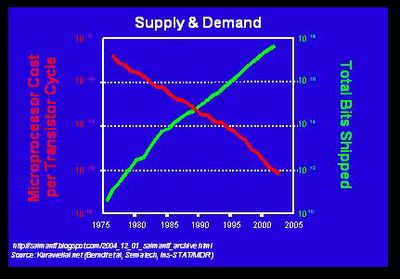The Blog Reed-ing Law of Networks?
All those bloggers could have been there happily blogging in their sub groups, but I would have probably never found them (Certainly not via a google search – what would I be searching for?) had it not been for Fred’s post.
All networks are formed of sub networks, and blogs are a perfect example of this. A group of mutually-admiring friends may be blogging for ever and ever – no thousands of such groups may be blogging for ever and ever with out really adding to the value of the network exponentially. So the main issue I would have with Reed’s law is that it does not account for the connection between the various sub groups. And that is where I think the real value lies (not the fact that they can be formed). Reed and Metcalf calculate a theoretical value for a network (and its subnetworks) but as these sub-networks become more and more specialized, what matters more is the actual interconnectedness of the sub-networks.
Take ebay’s example from Bubble-Generation: Could it be that ebay has turned into a series of unconnected sub-networks which don’t add value to each other exponentially, thus accounting for their lack of “network scale economies”? Are ‘car sellers’ and ‘antique dealers’ on ebay simply two completely disjoint sub-groups adding little value to each other? The fact that I would go to ebay.com to find either does mean that there are branding economies of scale in the traditional (pre-internet) sense, but not necessarily anything exponential (unless ebay-car-dealers want to barter for antiques.) (Interesting that Reed’s original paper, which is admirable in its vision, cites ebay as the prime GFN.)
So, back to reed’s law – I wonder if there is way to mathematically model the connections I mentioned in the first paragraph above. Or perhaps there is a way to measure the value of that interconnectedness using empirical data on the way that bloggers and blog readers travel from one sub network to another and sometimes create hard connections between these networks, making them even more valuable. For example, let’s assume that bloglines (and/or other rss readers) allowed us to see the historical data on their users’ subscriptions (in the way that sourceforge allows researchers to study the behavior of the open source community). By mining this historical data, we could then see the progression (over time) of the various blogs the users are subscribed to. We can then correlate that with the various hyper-links and trackbacks that each of the subscribed-to bloggers has created to the others over time, and see to what extent these links create added readership and subscriptions. Since each subscription by a user adds value to that user by definition – why else would they subscribe? – we can get a sense of the actual practical value of the blogosphere as a “Group-Connecting Network”…
And there we have it: A new “blog-Reed-ing law of networks”…
__________________________Note: I realized that I have been talking about the value created in general, not the monetized value accrued to a single company. Of course with open networks such as the blogosphere (or open source communities for that matter), extracting $S from the value created is not necessarily straight forward… except if you recognize the potential of that value early on and build new monetizable value on top of it!

